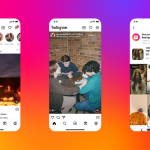If you’ve ever received a positive review of your products, had your brand mentioned in an article, or had a celebrity endorse your product (for free), you’ve experienced earned media.
Even if you haven’t been so lucky (yet), there’s lots of ways to encourage this type of free publicity. Here, we explain what earned media is, why it’s valuable and effective, and how to build a successful strategy for your brand.
What is earned media?
Earned media is any type of coverage or promotion your business receives that you didn’t pay for or create yourself. This includes social media posts, positive reviews, and media coverage from newspapers or other news sources. Word-of-mouth referrals can be considered earned media.
If your company got a positive review on Google after building a solid reputation, you earned it. Earned media is one of the most powerful ways to grow your brand presence, whether you sell donuts, t-shirts, or financial services.
How does earned media relate to owned and paid media?
Earned, owned, and paid media can all look similar—especially on social media. The difference lies in who is creating content for your business and whether you paid for it.
Owned media
Owned media is any content you or someone from your company creates to communicate and engage with your audience. This includes your business website, blog, social media channels, email newsletters, mobile apps, white papers, and ebooks. Even though Meta owns Instagram, the posts you publish to your account are considered owned media because you control the content.
Paid media
Paid media, known as paid advertising, includes any media coverage or ads you paid for. This includes display ads on websites, sponsored social media posts, influencer brand mentions you paid for, search engine advertising (such as pay-per-click ads), and native advertising (sponsored content that mimics the platform’s editorial content).
Earned media
Earned media is publicity your brand receives organically through word-of-mouth, media coverage, or other unpaid mentions you earn. This includes positive reviews, social media shares and mentions, press coverage, and recommendations or referrals from satisfied customers.
Is earned media effective?
Yes, earned media is an effective way to strengthen brand recognition, build authority in your market, and save money on your marketing strategy. Some marketing professionals say earned media coverage is the most effective way to influence consumer behavior. According to Nielsen’s 2021 Trust In Advertising Study, earned media—particularly recommendations from family and friends—remains the most trusted form of advertising globally. Nearly 90% of potential customers trust recommendations from people they know, highlighting the power of word-of-mouth and positive earned media.
Research shows free publicity can have a greater effect on customer behavior than costly digital or print advertising. One 2020 study, published by global communications firm Edelman, found traditional ads have half the impact of earned media. Surveyed consumers preferred receiving information from technical experts or people like themselves, rather than ads.
4 examples of earned media
Social media mentions and shares
Online reviews
Traditional press coverage
Influencer endorsements
There are many distribution channels for earned media. Explore some common examples of earned media:
1. Social media mentions and shares
When customers voluntarily share your brand’s content or mention your products in their own social media posts, it can generate organic exposure that leads to increased brand visibility and organic traffic to your site. This content from non-influencers, also known as user-generated content (UGC), can generate authentic, organic earned media. Fans of temporary tattoo brand Inkbox share their favorite designs on Instagram using the hashtag #inkboxcommunity.
2. Online reviews
Reviews on platforms like Yelp, Google, and other specialized review sites can influence potential customers’ opinions, serving as a form of earned media. Digital media outlets, such as blogs and review sites that demonstrate expertise in your industry, are another place to gain earned media. You can increase your chances of getting this kind of coverage by familiarizing yourself with who is blogging or reviewing in your industry and sending them samples or press releases about new products.
3. Traditional press coverage
Positive coverage of your company in newspapers, magazines, and other media outlets can generate brand exposure and credibility. For example, The Washington Post’s Electric Vehicle Buying Guide gives readers information about new cars on the market. PR agencies have relationships with reporters that can help your business get this kind of earned media coverage.
4. Influencer endorsements
When influencers and content creators recommend or endorse your brand through their own channels without payment, it can generate valuable earned media. That’s because their followers trust their recommendations. For example, Eight Sleep, a sleep fitness company, regularly gets mentioned in complimentary tweets by tech industry influencers. The founders showcase this earned media on a section of the company website called the Wall of Love.
How to build a successful earned media strategy
Identify your goals
Identify your audience and content creators
Create shareable content
Cultivate relationships
To gain earned media, consider taking the following steps:
1. Identify your goals
Decide whether you’re looking to increase local awareness of your brand, become a known expert in your industry, or increase engagement with your social media profiles. Identifying your business goals will help dictate the channels you use to execute your earned media strategy.
For example, to increase local awareness of your brand, you might reach out to local journalists with information about an upcoming event you’re hosting for the community. To establish yourself as an expert, you can offer to write guest posts for a blog concerned with your industry. To encourage engagement, try reposting user-generated photos of your products on social media and tagging the creator.
2. Identify your audience and content creators
Who are your customers and where can you find them? Think about where they congregate, both online and in real life. Who is writing about your industry and actively posting and influencing your target audience? When you know who you want to talk to, it makes it easier to build those relationships.
3. Create shareable content
Shareable content might include promotional materials for an in-person or online event, educational infographics, memes involving your product or service, or high-quality photos bloggers and journalists can use to accompany reviews of your products.
4. Cultivate relationships
Depending on your goals, cultivate relationships with media professionals, customers, influencers and content creators, or all of the above.
Media professionals: Send reporters appropriate, targeted pitches that extend your brand reach. For instance, a technology reporter isn’t interested in your sale on clay pots, but they might want to know you’re the only company in town using a 3D printer to make them. Reporters look for timely and previously unreported information, so reach out in advance of any new product release or event and note the newsworthiness in your email.
Customers: Whenever you see a customer praising your product or service on social media, leave a comment expressing your appreciation. Respond to both positive and negative reviews with thanks or an offer to solve their problem.
Content creators: To gain earned media from content creators, offer your time as an expert they can interview on their channels or share owned media that they can cross-promote. Repost any creator content mentioning your business to increase the impressions those posts receive.
Find influencers to promote your products with Shopify Collabs
Install the Shopify Collabs app today to partner with creators, promote your products, reach new customers, grow your sales, and track affiliate campaign performance all from Shopify admin.
Install the Shopify Collabs app
Earned media FAQ
Is social media earned media?
It can be. When someone shares your post, retweets you, or tags you in their own review, that’s earned media. The content you create and share on social media is owned media and sponsored social posts and paid ads are paid media.
Is SEO earned media?
No, search engine optimization (SEO) is part of your owned media strategy. It is something you do to your own website in order to boost your rankings in search results.
What is the difference between earned and unearned media?
Unearned media is another name for paid media. This includes content, mentions, and advertisements you pay to produce and distribute. Earned media includes the shares, links, and articles you don’t pay for, whether from a review site, a customer’s Instagram feed, or a news article mentioning your company’s products.
How can I track or measure my earned media strategy?
You can track publicity gained through earned media by metrics such as shares and clicks on social media sites, incoming links to your website, and mentions of your company on social media or in the media.






0 Comments